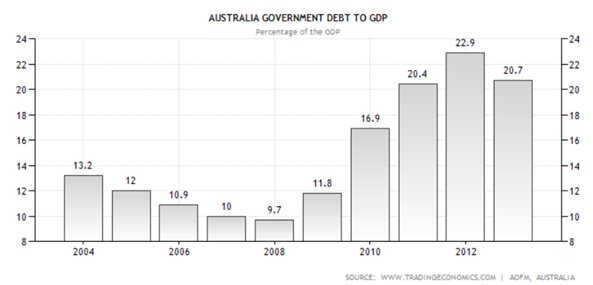There are three pervasive myths in Australia regarding debt. The first is that it is an indicator of sound financial management. It isn't.
The second is that Australia has a debt problem. It hasn't.
The third is that Australia weathered the global financial crisis (GFC) because it had no debt at the outset. Not true.
Let's look at the evidence. First proposition first.
Advertisement
Tony Abbott decries Australia's "skyrocketing debt". Rupert Murdoch's tame economists condemn the "spiralling debt". Economists and observers abroad regard these attacks as just bizarre.
To buy a house, most families find it strategic to borrow. Small businesses, farms and large corporations use overdraughts to operate efficiently. States and nations benefit greatly from borrowings. Generally, the higher the mortgage, the greater the long-term gain. Provided, of course, repayments are manageable and funds are put to productive use.
So what has Australia got to show for its recent increased borrowings? Well, at the micro level, new roads, railways, energy and water infrastructure, improved school facilities, insulation, social housing, defence housing and other public assets. At the macro level, the strongest economy in the world – and virtually guaranteed to stay that way.
That's measured by income, growth, jobs, inflation, interest rates, taxes, productivity, savings, terms of trade, credit ratings and other variables.
Second, the proposition that Australia has a debt problem is just laughable abroad. Australia's net borrowings – money borrowed minus money lent out – is currently 11.6% of annual income, as measured by gross domestic product (GDP).
Of the 35 advanced economies on the International Monetary Fund (IMF) database, only five rich nations with a fraction of Australia's population now have lower net debt to GDP – Denmark, Estonia, Finland, Norway and Sweden.
Advertisement
Several are now above 70%, including Belgium, France, Israel, the UK and the USA. Ireland and Portugal are above 100%. Japan is above 130%.
In historic terms, 11.6% net and 20.7% gross are unremarkable. Australia has exceeded 50% gross three times in the last 100 years and went above 100% during World War II.
Unlike most nations, Australia's debt is declining and set to decline further. Only ten wealthy nations reduced gross debt to GDP last year. Australia's 2.2% reduction was only bettered by Iceland and Norway.

Discuss in our Forums
See what other readers are saying about this article!
Click here to read & post comments.
94 posts so far.